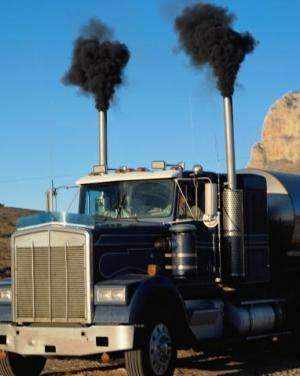Climate benefit for cutting soot, methane smaller than previous estimates

Cutting the amount of short-lived, climate-warming emissions such as soot and methane in our skies won't limit global warming as much as previous studies have suggested, a new analysis shows. The study also found a comprehensive climate policy would produce more climate benefits by 2050 than if soot and methane were reduced alone.
"Cutting back only on soot and methane emissions will help the climate, but not as much as previously thought," said the study's lead author, climate researcher Steve Smith of the Department of Energy's Pacific Northwest National Laboratory. "If we want to stabilize the climate system, we need to focus on greenhouse gases such as carbon dioxide, nitrous oxide and methane. Concentrating on soot and methane alone is not likely to offer much of a shortcut."
The new study will be published the week of Aug. 12 in Proceedings of the National Academy of Sciences Early Edition online. Smith works at the Joint Global Change Research Institute in College Park, Md., a joint venture between PNNL and the University of Maryland.
At least two studies have been published since 2010 that suggest reducing soot and methane would cut human-caused global temperature increases by half of a degree Celsius, or about 1 degree Fahrenheit, by 2050. International leaders took note and formed the Climate and Clean Air Coalition to Reduce Short-Lived Climate Pollutants in 2012.
Soot and methane are called short-term climate forcers because they only remain in the atmosphere for a relatively short time: a couple weeks for soot and up to a decade for methane. Meanwhile, the better-known climate change culprit carbon dioxide can stick around for 1,000-plus years. Soot, also known as black carbon, is made of fine, carbon-based particles that are given off by car and truck tailpipes and wood stoves. Methane, the main component of natural gas, is released from leaking pipelines, coal mines, oil wells, cattle, rice paddies and landfills.
A modeled future
Smith and his former research assistant Andrew Mizrahi used a PNNL computer model, the Global Change Assessment Model, or GCAM, to evaluate the impact of reducing soot and methane emissions on Earth's climate. GCAM is especially suited for projections such as this because it takes into account ongoing future changes in technology, society and the economy, including energy and land use. The model also incorporates greenhouse gases and pollutants that can result from those activities. Earlier studies of short-lived climate pollutants did not use an integrated, dynamic model such as GCAM.
With PNNL's climate model, Smith created more than 1,400 potential scenarios to reflect the many possibilities surrounding aerosols, tiny particles including soot that float in the atmosphere. The impact of aerosols on past and future climates has yet to be definitively determined. Ongoing PNNL research is evaluating how aerosol particles affect the atmosphere, including temperature and precipitation. The model also considered how reducing soot could impact other atmospheric emissions, including sulfur dioxide, nitrous oxide and organic carbon.
The study examined what the future could look like in an idealized world where soot and methane emissions were severely cut by 2035. All feasible and available technology was used to eliminate as much methane as possible. And all wood- and biomass-burning stoves were replaced with cleaner, modern stoves that use electricity or natural gas for energy. Finally, all cars and trucks were assumed to be equipped with advanced soot emission controls.
Highest possible reduction isn't so high
The research found that cutting soot and methane as described above produced an average temperature reduction of 0.16 degrees Celsius by 2050, which is substantially less than the 0.5-degree reduction found in earlier studies. When looking at individual scenarios that employed various assumptions about aerosols, temperature reductions varied from a low of just 0.04 degrees to a high of 0.35 degrees.
For further comparison, Smith also evaluated these results against what would happen if a comprehensive climate policy were enacted. Earlier PNNL research developed such a scenario, which includes substantially reducing all greenhouse gas emissions, instead of only limiting carbon dioxide as the previous short-lived climate pollutant studies did for their comparative scenario.
While focusing on reducing all greenhouse gas emissions, including methane, the comprehensive climate policy scenario also reduced the amount of soot in the atmosphere. As a result, the climate policy scenario lowered global average temperatures by 0.27 degrees in 2050, which is more than when only short-lived climate forcers were controlled. The comprehensive climate policy scenario also provided much larger temperature reductions through 2100.
"Focusing on soot and methane may be worth targeting for health reasons, as previous studies have identified substantial health benefits from reducing those emissions," Smith said. "To stabilize the global climate, however, the focus needs to be on carbon dioxide and other greenhouse gases."
More information: Steven J. Smith and Andrew Mizrahi," Near-Term Climate Mitigation by Short-Lived Forcers," PNAS, Aug. 12, 2013, DOI: 10.1073/pnas.1308470110
Journal information: Proceedings of the National Academy of Sciences
Provided by Pacific Northwest National Laboratory

















